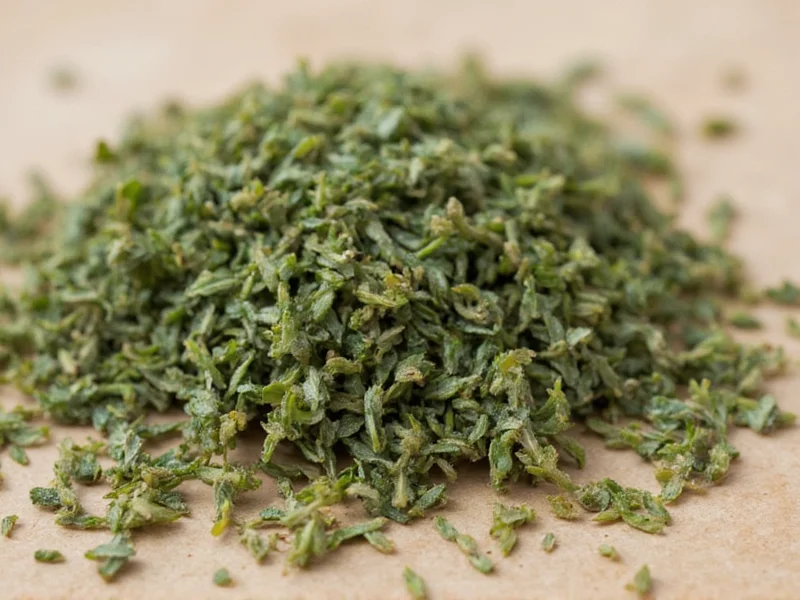The Science Behind Dried Leaf Thyme
When fresh thyme undergoes the drying process, water-soluble compounds evaporate while oil-soluble flavor elements become more concentrated. This transformation creates a fundamentally different flavor profile compared to its fresh counterpart. The drying method significantly impacts quality—air-dried thyme typically preserves more volatile oils than oven-dried varieties, while freeze-dried options maintain closer flavor resemblance to fresh thyme.
Understanding the chemical changes during dehydration explains why dried leaf thyme vs fresh thyme requires different culinary approaches. Thymol, the primary flavor compound in thyme, becomes more pronounced during drying, giving dried thyme its characteristic pungency. This concentration means professional chefs universally recommend using one-third the amount of dried thyme when substituting for fresh in recipes.
Practical Culinary Applications
Dried thyme shines in dishes requiring extended cooking times where its robust flavor can fully integrate. Unlike fresh thyme sprigs that lose potency during long simmers, dried leaf thyme maintains its flavor integrity throughout the cooking process. Consider these optimal applications:
- Slow-cooked dishes: Add during the initial stages of stews, braises, and bean dishes
- Dry rubs: Combine with other dried herbs and spices for meats
- Bread doughs: Incorporate into focaccia or herb bread recipes
- Tomato-based sauces: Complements acidity while adding depth
| Application | Recommended Timing | Dried Thyme Amount |
|---|---|---|
| Long-simmered sauces | Beginning of cooking | 1/4 tsp per cup of liquid |
| Dry meat rubs | Before cooking | 1/2 tsp per pound of meat |
| Roasted vegetables | Before roasting | 1/8 tsp per pound of vegetables |
| Bread doughs | During mixing | 1/2 tsp per cup of flour |
Storage Techniques for Maximum Longevity
The shelf life of dried thyme depends entirely on storage conditions. Exposure to light, heat, and humidity rapidly degrades volatile oils responsible for flavor. Follow these evidence-based storage practices:
Store dried thyme in an airtight glass container with an oxygen absorber packet in a cool, dark cupboard. Avoid clear containers that allow light penetration. Never store near heat sources like stoves or ovens. Properly stored, high-quality dried thyme maintains peak flavor for 12-18 months, though it remains safe indefinitely if protected from moisture.
Test your dried thyme freshness by rubbing a small amount between your fingers and inhaling deeply. Fresh dried thyme should release a strong, pleasant herbal aroma. If the scent is faint or musty, the thyme has lost significant flavor compounds and should be replaced. Never store dried herbs in the refrigerator where humidity causes condensation.
Nutritional Profile and Health Benefits
Drying concentrates certain beneficial compounds while reducing others. Compared to fresh thyme, dried leaf thyme contains higher concentrations of:
- Antioxidants: Particularly rosmarinic acid and lutein
- Minerals: Iron, manganese, and calcium become more concentrated per volume
- Thymol: The active compound with antimicrobial properties
Research published in the Journal of Agricultural and Food Chemistry confirms that while vitamin C content decreases during drying, many polyphenolic compounds actually increase in concentration. This makes properly stored dried thyme nutritional benefits particularly valuable for supporting respiratory health and providing antioxidant protection.
Avoiding Common Culinary Mistakes
Even experienced cooks make critical errors when working with dried leaf thyme. Understanding these pitfalls ensures optimal flavor extraction:
Mistake 1: Incorrect substitution ratios - Using equal amounts of dried thyme when substituting for fresh results in overpowering dishes. Remember the 1:3 ratio - one teaspoon of fresh thyme equals one-third teaspoon dried.
Mistake 2: Adding too late in cooking - Unlike fresh thyme which benefits from late addition, dried thyme requires time to rehydrate and release flavors. Add during the first half of cooking for soups and sauces.
Mistake 3: Poor storage practices - Keeping dried thyme in clear containers on spice racks exposed to kitchen light and heat dramatically shortens its shelf life of dried thyme. Transfer to opaque containers immediately after purchase.
Reviving Subpar Dried Thyme
When your dried leaf thyme has lost potency but isn't completely degraded, try these professional techniques to maximize remaining flavor:
- Toast gently: Warm in a dry skillet over low heat for 30-60 seconds to release volatile oils
- Crush before use: Rub between palms to break cell walls and release essential oils
- Infuse in oil: Steep in warm olive oil for 15 minutes before using in dressings
- Combine with acid: Pair with lemon juice or vinegar to enhance flavor perception
For severely degraded thyme showing no aroma, replacement is the only solution. No technique can restore flavor compounds that have fully oxidized. When purchasing new dried thyme, check for vibrant green color (not brownish) and strong fragrance at the store.











 浙公网安备
33010002000092号
浙公网安备
33010002000092号 浙B2-20120091-4
浙B2-20120091-4